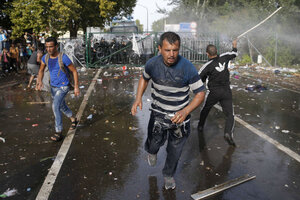As Hungary closes borders, migrants scramble to find new routes north
Thousands of refugees are rethinking their travel plans as Hungary tightens its southern border. Croatia is offering safe passage. But what other dangers lie ahead?

Migrants run as Hungarian riot police fire tear gas and water cannon at the border crossing with Serbia in Roszke, Hungary on Wednesday. Migrants are demanding they be allowed to enter from Serbia on the second day of a border crackdown.
Marko Djurica/Reuters
They are sleeping in tents and on highways, taking shelter in abandoned buildings. Some throw water bottles. At least one boisterous crowd managed to hack through a razor wire fence. In a controversial move, Hungarian police have responded with tear gas.
These are only some of the scenes unfolding as Hungary decided to close its southern border on Tuesday, leaving hundreds stranded on the other side of the fence in Serbia and thousands more to rethink their routes to reach Germany or other countries that so far have welcomed migrants in Europe’s largest border crisis.
Budapest this week began to tighten its borders with Serbia and Romania, declaring a state of emergency as it dispatched hundreds of law enforcement officials – and in some cases, soldiers – to secure the fences being broken down by frustrated refugees. The Serbian government condemned Hungary’s use of tear gas on Wednesday, saying it expressed the “harshest possible protest” against the decision, according to The Associated Press.
The first country to begin prosecuting migrants, Hungary also sealed a railway crossing near Roszke that had led tens of thousands into Europe’s borderless Schengen zone, reports the BBC.
In this short time, Hungarian police said Wednesday, more than 360 migrants have been detained from trying to enter the country illegally. And after expedited proceedings, at least one Iraqi has already been convicted and deported, according to The New York Times.
But where will the refugees go, if they can't get into Hungary?
The prime minister of Croatia has promised migrants safe passage, opening up another potential route to the north. “No one will block them,” said Prime Minister Zoran Milanovic, according to the Times. “No fences.”
Not soon after on Wednesday, dozens began to flood in, according to BBC – knowing that their journey is far from over. The refugees’ entry into Croatia, Mr. Milanovic emphasized, is based on the condition that they merely pass through to another destination – mostly targeted by asylum seekers as Germany.
But this doesn’t mean there aren’t still dangers ahead. The border between Serbia and Croatia is still riddled with landmines left behind from the Croatian war of independence two decades ago, local media has reported. But some experts say remaining landmines are clearly marked in specific areas.
Slovenia – which would serve as the next transit point after Croatia – has also moved to introduce emergency security on the border it shares with Hungary, reports The Guardian. This followed shortly after Austria’s decision to do the same on Hungary's west side.
Even the migrants able to pass into Slovenia will be met with fresh physical challenges, according to NPR, such as crossing high mountain ranges. And many of these migrants are traveling with young children, making passage more difficult.
There are reports that some Syrians are looking at a northerly route into Europe via Russia.
Meanwhile, some refugees back at the sealed Hungarian border hold out hope that politicians will be able to reach a favorable resolution.
“I’m hoping the border will open,” Mohamed Afar, a 23-year-old Syrian refugee stranded in Serbia, told the Times. “I will wait. Maybe Ms. Merkel comes to open it? The Hungarian government seems to have no mind or heart. Can’t they see all these families? There is nothing for us here.”

